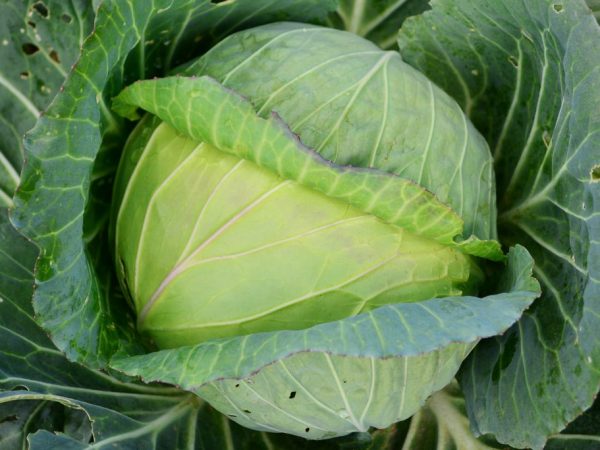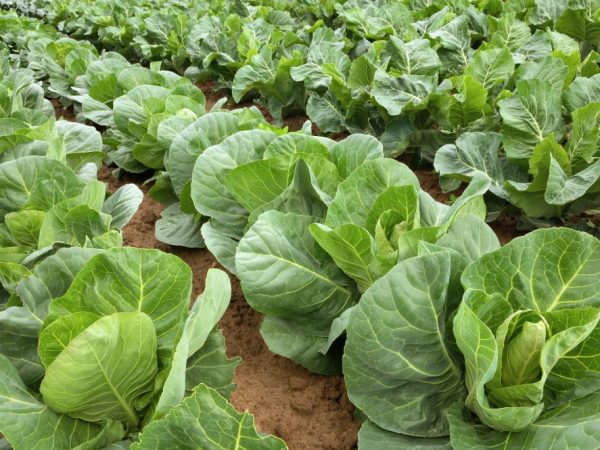Description of cabbage Kolobok
Cabbage Kolobok category F1 is characterized by high yield rates. The hybrid received special recognition in everything due to a large number of its merits. Even with long-term storage in winter, this variety does not lose its commercial and taste characteristics.

Description of cabbage Kolobok
Characteristics of the variety
Cabbage Kolobok category f1 was bred in Russia and obtained by crossing such popular varieties as Belarusian white cabbage and Russian Slava.
In 2004, the variety got its place in the State Register of the Russian Federation. It is believed that it can be grown in all regions of the country.
Fetal appearance
The heads are round and rather large in size, the weight of an individual cabbage is 5 kg. The height of a white-headed fruit can reach 25 cm. Outside, the fruit is presented in green, but when cross-sectioned, it changes to light yellow.
The yield of the Kolobok cabbage is high. On average, about 700 kg of selected products can be harvested from 1 hectare. It is possible to collect about 15 kg of high-quality goods from 1m2. The root system is very developed, which helps the seedlings to strengthen in the soil.
Cabbage Kolobok category f1 is characterized by versatility in use. You can use it to prepare fresh salads, first courses, or use it for fermentation. Storage, without loss of marketability and taste, is possible for 6 months.
Growing principle
The description of the cabbage variety Kolobok category f1 indicates that its planting should be carried out only by the seedling method. To do this, at the end of March, plant seeds in special containers. It should be noted that all seeds must necessarily undergo preparation: they are placed in water for half an hour at a temperature of 50-60 ° C. After that, you need to rinse under cold running water. The seeds are planted at a distance of 5 cm from each other, and the depth of their immersion in the soil is about 2 cm. In order for the first shoots to appear faster, it is recommended to adhere to the optimum temperature in the room. It is better if it does not exceed 12-15 ° C.
The best time to plant a crop in open ground is the beginning of May. For cultivation, select only those areas that are not in the shade of other plants. The soil should be determined according to the principle that it is fertile and does not contain a high level of acid-base balance. Usually, it should not exceed 6%. Otherwise, it is important to add lime.
Cabbage variety Kolobok should be planted in open ground only after 3 pairs of leaves have formed on the seedlings. This usually happens 40-45 days after planting the seeds. Cabbage Kolobok should be planted in the morning or in the evening so that direct sunlight does not disturb the structure of the stem. It is necessary to adhere to a distance of 50 cm between the rows, and 60 cm between the holes.
Planting without seedlings
At the beginning of May, around the 10th, you should dig holes for planting on the site. The distance between them should be 65-75 cm.The seeds of this hybrid variety are spread to a depth of about 2 cm, and the holes are carefully filled up. It is recommended to cover all rows with a layer of plastic wrap to create a greenhouse effect. These plants should be watered once a week.
The main advantage of this method is that such seedlings are more resistant to negative environmental factors. After all, a seedless growing method significantly reduces the risk of disease.
Care rules

Regular watering is important for plants.
Cabbage Kolobok f1 badly needs soil moisture. If watering is not timely, the seedlings will quickly stop growing and dry out. When plants are watered too often, there is a risk of many diseases, in particular root rot. The seedlings should be moistened as the soil dries up: at least 12 liters of warm water should fall on 1m2.
After each watering, you need to loosen the soil and remove all weeds. The recommended weeding depth is 6-7 cm. This is enough for the soil to loosen up and the roots remain intact. Weeding and weeding can reduce the risk of disease.
Top dressing
Top dressing of white cabbage Kolobok should be carried out several times, during the entire growing season.
- It is carried out 2 weeks after planting in open ground. At this point, a special solution should be added (dilute 20 g of nitrate, 10 g of superphosphate and 20 g of potassium in 10 liters of water). 10 bushes should have about 300 ml of solution.
- It is carried out 14 days after the first. From this period of time, organic fertilizers and mineral fertilizers should be combined. Dilute 500 g of chicken manure in 5 liters of water, and pour about 500 ml under each bush. You can also make a potassium tincture and use it for watering. Dilute 200 ml of the preparation in 10 l of water.
- Carried out 3 weeks before the start of the harvest. At this point, it is advisable to use a potassium solution. In 10 liters of warm water, you need to dilute 50 g of the drug.
Diseases and pests
The description of the Kolobok cabbage variety indicates that it can be susceptible to diseases such as keela, fusarium, black leg and gray rot. You can get rid of the first with the help of the drug Tiovit (for 5 liters of water, 50 g of the substance). In the fight against the black leg, it is advisable to use a solution of manganese or copper sulfate (5 g of the substance are diluted in 10 liters of water). Fusarium can not be cured, so the infected bushes must be immediately dug up and burned away from the garden plot. It is possible to eliminate gray rot only by removing all damaged leaves.
When growing cabbage gingerbread man, you can encounter pests such as flea beetles, cabbage fly or moth. In the fight against the first, it is recommended to use the drug Decis (5 ml per 5 liters of warm water). You can get rid of cabbage flies only with the help of Hexochlorane (10 ml per 5 liters of water). An effective method of fighting moths will be Lepidocide (50 ml per 5 liters of water).
Conclusion
White cabbage Kolobok is one of the most popular vegetable varieties. Many gardeners grow it to obtain a massive harvest of excellent quality. High yields are achieved without much effort in terms of maintenance or planting.


